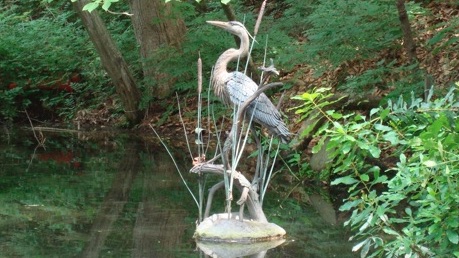William and Mary’s natural areas and campus landscaping benefit student mental health, giving students a space to relax and enjoy our natural world. Many campus clubs rely on having local habitat accessible on campus. The William and Mary Bird Club for example needs these natural spaces for club walks where they show students the vast bird biodiversity on campus. If there weren’t plants, however, the bird diversity would plummet.
Our campus is home to a wide range of flora, but a few species populations are declining. The concern underlying these declines is a decrease in local plant biodiversity. Invasive species introduced on campus (i.e. bamboo, wisteria, japanese honeysuckle, etc) significantly alter habitat by outcompeting native plant species, reducing biodiversity and affecting animal populations by changing the composition of the local environment. To protect the integrity of native biodiversity on campus the Native Plant Nursery (NPN), an EcoAmbassador internship program under the W&M Committee on Sustainability, works to support landscape efforts by providing native plants, which require less maintenance to thrive compared to non-native plants, and that support native animal populations.
The NPN was created in the 2013-2014 academic year by two students, Hannah Goad (W&M ’14) and Gus Tate (W&M ’15), who worked with three Biology department staff and faculty members, Patty White-Jackson (Greenhouse Manager), Beth Chambers (Herbarium Curator), and Martha Case (College Conservator of Botanical Collections) to identify declining woody plant species suitable for landscaping and establish a management plan to restore native plant populations.
The targeted species are:
- Decumaria barbara (climbing hydrangea)
- Ulmus alata (winged elm)
- Quercus prinus (chestnut oak)
- Quercus coccinea (scarlet oak)
- Quercus stellata (post oak)
- Quercus marilandica (blackjack oak)
- Quercus michauxii (swamp chestnut oak)
- Viburnum nudum (possumhaw)
- Oxydendrum arboretum (sourwood)
In 2014-2015 academic year, Kevin Xu (W&M ’16) worked with Chambers and White-Jackson to collect seeds and acorns from campus and the college woods and grow them in the Millington greenhouse. It is thanks to his efforts that I had 100 trees to work with this academic year.
This spring, the NPN partnered with the Student Environmental Action Coalition (SEAC) to help restore the Crimmdell to a beautiful, natural area at the heart of campus free of invasives and lush with native plants. SEAC has been working since the 2014-2015 academic year to remove the various invasive presence from the Crimmdell area. Recently, they began replacing the invasives with native plants; however, the plants SEAC is planting do not originate from the genetic stock on campus nor does SEAC specifically target declining species. The NPN uses only seeds and acorns from plants already on campus to ensure the planted individuals are adapted to the local climate. Partnering with SEAC benefits both parties – SEAC saves money on purchasing plants and the NPN has somewhere to put a few of its many trees.
On March 26th, 2016, I joined the SEAC work group in the Crimmdell. The SEAC team worked around me, sawing down bamboo, while I planted six winged elms on the incline of the Crimmdell. The simultaneous removal of invasives and restoration of natives facilitates a return to a healthier Crimmdell and mitigates soil loss due to erosion. The installation of these elms will set the precedence for future NPN planting around campus. The tree seedlings currently have tree guards wrapped around them to protect from predation by deer and small rodents, and are easily spotted from the path meandering through the Crimmdell. The other 90 or so tree seedlings growing in the nursery will be eventually be landscaped onto campus property and carry the genetics of their ancestors into the future, sustaining local ecological interactions and contributing to campus biodiversity. Thanks to the Native Plant Nursery and its partners, students and students groups like the Bird Club will be able to enjoy the native flora and fauna for years to come.
Email Erin Chapman at eechapman@email.wm.edu
eechapman@email.wm.edu

